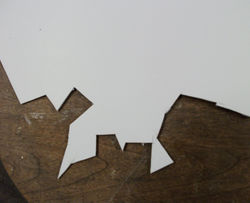 Installation lighting |  *Shown w/ Gallery Lighting (& w/o metal component) |  Shown in traditional gallery lighting |
|---|---|---|
 Installation lighting |  Shown in traditional gallery lighting |  Shown in traditional gallery lighting |
 Installation Lighting |  Shown in traditional gallery lighting |  Shown in traditional gallery lighting |
 Installation lighting |  Installation lighting |  Shown in traditional gallery lighting |
 |
GEOVINE [PRIME]
CAST IRON, STEEL, BRASS, MDF, PLYWOOD, CAST PLASTIC, ACRYLIC PAINT, LIGHT
61” x 11.5” x 11”
2013 - 2023
RELEVANT EXCERPT FROM
"The Compendium of GeoDinic [Natural] History" :
The GeoPods are not an organic part of the vines, but rather a by-product of their growth (like a pearl in an oyster). This specimen is in prime middle-age, between 500 and 700 years old (represented both by the bright orange coloring, and the near-spherical arrangement of the now-separated sections of the Pod). By this time in its life-cycle, the pod has opened up and hollowed out. At any age, the Pod’s interiors are a darker grey than their exteriors, and transition to a cool tone on the facets closest to the split (in this case/at this age: cobalt blue). This feature is likely due to the properties of the interior environment combined with a longer exposure to the air of GeoDin, which is very dense and contains high concentrations of several unfamiliar elements. The Pods were this world’s most precious natural resource, and were used by the people of GeoDin to generate energy (this energy is similar to direct-current electricity, but less potent and even more difficult to transmit across distances).
ABOUT THIS PIECE:
This was actually the first piece from this show that I made, and in many ways the rest of the work is based on it. It was something of a breakthrough in my work, and was incredibly fun to make; precise and exacting and slow (a few of my favorite things). I got to use math and measure angles and solve a zillion problems and I loved every second. I also loved the colors I ended up with. When designing these plants, I wanted to create a life-form that felt completely different from what our world actually produces, which lead me to the question: “What is not the color of grass?” (answer: orange). I absolutely fell in love with the affect of the stepped-gradient I achieved by painting progressively darker shades of orange onto the different facets. This discovery ended up transforming my entire aesthetic and is still a huge part of my work today.
GEOVINE [PRIME] - Drawings, Plans, & In-Progress Shots
 Scan of original drawing; Pen and colored pencil |  |  |
|---|---|---|
 |  |  |
 |  |  Making pieces to fit the Geo |
 |  Toothpick pegs |  |
 Oranges! |  |  |
 |  |  |
 |  Pedestal concept drawing |  |
 |  |  Styrofoam patterns for Cast Iron gears |
 |  |  |
 |  |  |
 |  |  |
 |  |  |
